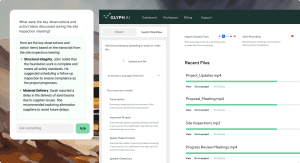An advanced AI assistant that listens to technical meetings, takes notes and flags follow-ups has been launched for the architecture and construction sectors
Glyph AI said its “superhuman” AI assistant is designed to improve productivity, reduce miscommunication and streamline documentation.
In addition to listening during meetings to capture detailed technical notes and identifying follow-up actions, the tool is capable of answering questions or drafting emails about meetings.
Unlike generic transcription tools, Glyph AI has been specifically trained in construction terminology.
It uses a diverse prompt library that enables it to automatically generate industry-specific notes, from categorizing site inspection reports to updating project statuses, conducting safety briefings, processing change orders, and more.
What is AI transcription?
Speech-to-text models employ AI technology to convert human speech into text, eliminating the need for manual notetaking. This software listens to conversations, audio or video files and translates them into text with human-level accuracy.
However, a raw transcript of conversations often isn’t the most helpful format for consuming information.
Here, AI assistants powered by Large Language Models (LLMs) play a crucial role. LLMs can summarize and structure transcripts, uncovering insights, and highlighting follow-ups. Prompts direct these LLMs, instructing them to perform specific actions based on user requirements.
Daniel Htut, CEO of Glyph AI, said: “As someone who has worked in construction, I’ve seen first-hand the need for an AI meeting co-pilot that goes beyond basic notes.”
 Key features
Key features
- AI speech-to-text: Accurately transcribes meetings with human-level precision.
- Non-intrusive recording: Records virtual meetings via AI screen recorder or in-person meetings via mobile app seamlessly.
- Industry-specific prompt library: Generates detailed technical meeting notes with construction terminology.
- AI chat interface: Enables real-time querying of meeting insights and action items.
- Custom vocabulary training: Fine-tuned on construction terms for improved accuracy.
- Collaborative workspace: Facilitates team collaboration through shared meeting notes.
“We are committed to continuing our work with construction and architecture firms,” Htut said.
“These industries have historically been slow to adopt new technologies, presenting us with an opportunity to drive significant improvements.”

